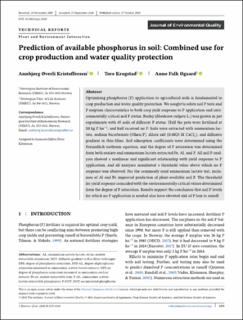| dc.contributor.author | Kristoffersen, Annbjørg Øverli | |
| dc.contributor.author | Krogstad, Tore | |
| dc.contributor.author | Øgaard, Anne Falk | |
| dc.date.accessioned | 2021-02-24T10:58:16Z | |
| dc.date.available | 2021-02-24T10:58:16Z | |
| dc.date.created | 2021-01-05T12:58:58Z | |
| dc.date.issued | 2020-10-02 | |
| dc.identifier.citation | Journal of Environmental Quality. 2020, 49 (6), 1575-1584. | en_US |
| dc.identifier.issn | 0047-2425 | |
| dc.identifier.uri | https://hdl.handle.net/11250/2730033 | |
| dc.description.abstract | Optimizing phosphorus (P) application to agricultural soils is fundamental to crop production and water quality protection. We sought to relate soil P tests and P sorption characteristics to both crop yield response to P application and environmentally critical soil P status. Barley (Hordeum vulgare L.) was grown in pot experiments with 45 soils of different P status. Half the pots were fertilized at 20 kg P ha−1, and half received no P. Soils were extracted with ammonium lactate, sodium bicarbonate (Olsen P), dilute salt (0.0025 M CaCl2), and diffusive gradient in thin films. Soil adsorption coefficients were determined using the Freundlich isotherm equation, and the degree of P saturation was determined from both oxalate and ammonium lactate extracted Fe, Al, and P. All soil P analyses showed a nonlinear and significant relationship with yield response to P application, and all analyses manifested a threshold value above which no P response was observed. For the commonly used ammonium lactate test, inclusion of Al and Fe improved prediction of plant‐available soil P. The threshold for yield response coincided with the environmentally critical values determined from the degree of P saturation. Results support the conclusion that soil P levels for which no P application is needed also have elevated risk of P loss to runoff. | en_US |
| dc.language.iso | eng | en_US |
| dc.publisher | John Wiley & Sons Ltd. | en_US |
| dc.rights | Navngivelse 4.0 Internasjonal | * |
| dc.rights.uri | http://creativecommons.org/licenses/by/4.0/deed.no | * |
| dc.title | Prediction of available phosphorus in soil: Combined use for crop production and water quality protection | en_US |
| dc.type | Peer reviewed | en_US |
| dc.type | Journal article | en_US |
| dc.description.version | publishedVersion | en_US |
| dc.rights.holder | © 2020 The Authors | en_US |
| dc.source.pagenumber | 1575-1584 | en_US |
| dc.source.volume | 49 | en_US |
| dc.source.journal | Journal of Environmental Quality | en_US |
| dc.source.issue | 6 | en_US |
| dc.identifier.doi | 10.1002/jeq2.20165 | |
| dc.identifier.cristin | 1865539 | |
| cristin.ispublished | true | |
| cristin.fulltext | original | |
| cristin.qualitycode | 1 | |

